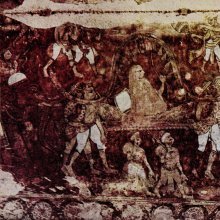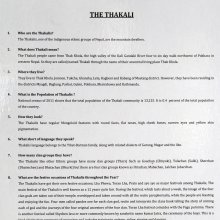Young boy: 1 definition
Introduction:
Young boy means something in the history of ancient India. If you want to know the exact meaning, history, etymology or English translation of this term then check out the descriptions on this page. Add your comment or reference to a book if you want to contribute to this summary article.
Images (photo gallery)
India history and geography
Source: Singhi Jain Series: Ratnaprabha-suri’s Kuvalayamala-katha (history)Young boys were commonly depicted on the Saṃsāracakra paintings (representing scenes of human life), in ancient India, as mentioned in the Kathās (narrative poems) such as Uddyotanasūri in his 8th-century Kuvalayamālā (a Prakrit Campū, similar to Kāvya poetry).—Page 185.21 f.: Here follows a description of a printed scroll illustrating the Jaina conception of saṃsāracakra. [...] The saṃsāra-cakra illustrated the three worlds of hell, human world and the world of gods. [For example:] A young boy amusing himself with the fight of cocks, male parrots, rams; a young man enjoying the company of young girls and maidens.

The history of India traces the identification of countries, villages, towns and other regions of India, as well as mythology, zoology, royal dynasties, rulers, tribes, local festivities and traditions and regional languages. Ancient India enjoyed religious freedom and encourages the path of Dharma, a concept common to Buddhism, Hinduism, and Jainism.
See also (Relevant definitions)
Full-text (+34): Kadukuvara, Hasuhuduga, Elamaga, Kadutaruvali, Cinniga, Damgani, Valukkaippayal, Balabrahmacari, Balasanyasi, Gopala, Lala, Eleya, Kumarakavada, Jatakaranakarman, Kumaraka, Radha, Kumara, Putra, Daraka, Shishu.
Relevant text
Search found 51 books and stories containing Young boy; (plurals include: Young boies). You can also click to the full overview containing English textual excerpts. Below are direct links for the most relevant articles:
Bhakti-rasamrta-sindhu (by Śrīla Rūpa Gosvāmī)
Verse 2.1.341 < [Part 1 - Ecstatic Excitants (vibhāva)]
Verse 2.4.72 < [Part 4 - Transient Ecstatic Disturbances (vyābhicāri-bhāva)]
Verse 3.4.20 < [Part 4 - Parenthood (vātsalya-rasa)]
Chaitanya Bhagavata (by Bhumipati Dāsa)
Verse 2.4.46 < [Chapter 4 - Revelation of Nityānanda’s Glories]
Verse 1.2.59 < [Chapter 2 - The Lord’s Appearance]
Verse 2.12.3 < [Chapter 12 - The Glories of Nityānanda]
Rig Veda (translation and commentary) (by H. H. Wilson)
Rig Veda 8.69.15 < [Sukta 69]
Aurangzeb - Dara Shikoh < [July – September, 2001]
How Strange are the Ways of God! < [April – June, 2006]
The Brick < [October – December, 2007]
Vinaya Pitaka (3): Khandhaka (by I. B. Horner)
Allowance to proclaim by clan < [1. Going forth (Pabbajjā)]
First recitation section < [17. Schism in an Order (Saṅghabheda)]
The Bhikkhus Rules (by Bhikkhu Ariyesako)
Becoming A Novice < [Part Two]

